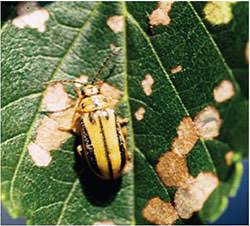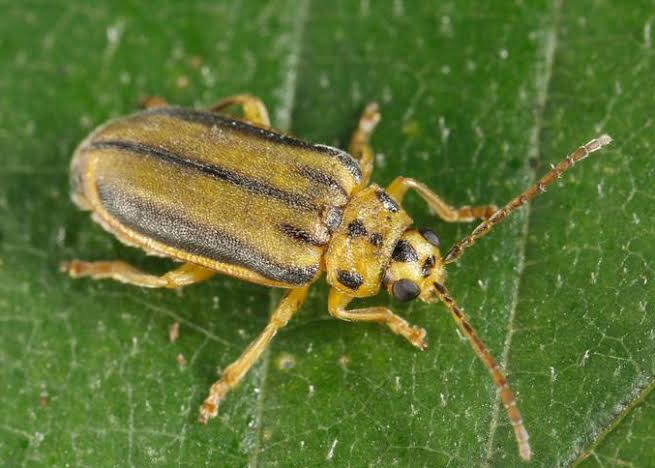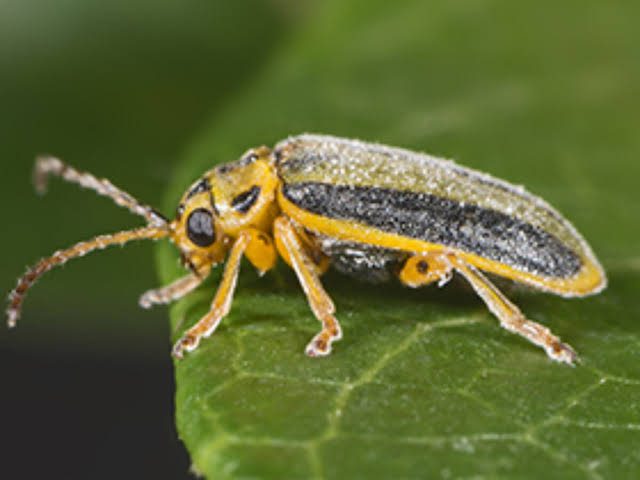The Elm Leaf Beetle, scientifically known as Xanthogaleruca luteola, is a tiny insect that can have a big impact on elm trees. These beetles are quite small, typically measuring around a quarter of an inch in length. Despite their size, they play a significant role in the health of elm trees, and their presence can be both a concern and a challenge for tree enthusiasts.
Elm Leaf Beetles are easily recognizable by their vibrant yellow-green color, which distinguishes them from other insects. They have a shield-shaped body and distinctive black stripes along their wings. These beetles are not native to North America but were introduced from Europe. Unfortunately, since their introduction, they have become a common pest for elm trees.
One of the primary concerns associated with Elm Leaf Beetles is their feeding habits. These beetles feed on the leaves of elm trees, consuming the green tissue and leaving behind skeletonized leaves. This feeding behavior can weaken the trees over time, affecting their overall health. Severe infestations may lead to defoliation, causing stress to the elm tree and making it more susceptible to diseases.
Controlling Elm Leaf Beetle infestations can be challenging. Traditional methods include the use of insecticides, but these must be applied with care to avoid harming beneficial insects and other wildlife. Additionally, some beetles may develop resistance to certain chemicals over time, necessitating the exploration of alternative control measures.
Natural predators, such as certain parasitoid wasps, can also help keep Elm Leaf Beetle populations in check. These wasps lay their eggs on the beetle larvae, providing a natural control mechanism. However, relying solely on these predators may not be sufficient in cases of severe infestations.
Tree owners and arborists often monitor elm trees for early signs of beetle activity. Regular inspections allow for prompt intervention, minimizing potential damage. Integrated pest management, which combines various strategies such as cultural practices, biological controls, and targeted chemical treatments, is often recommended for effective and sustainable Elm Leaf Beetle control.
The Elm Leaf Beetle, with its scientific name Xanthogaleruca luteola, poses a significant challenge to the health of elm trees. Recognizable by their vibrant color and distinctive markings, these beetles feed on elm leaves, potentially causing defoliation and weakening the trees. Managing Elm Leaf Beetle infestations requires a comprehensive approach that considers both chemical and natural control methods to ensure the long-term health of elm trees.
Read Also: Health Benefits and Side Effects of Opium Poppy (Papaver Somniferum)
Plants Affected by Elm Leaf Beetle (Xanthogaleruca luteola)

Elm leaf beetles primarily target elm trees, causing potential harm to various species within the Ulmus genus. Common elm tree species affected by these beetles include the American Elm (Ulmus americana), European Elm (Ulmus glabra), and Chinese Elm (Ulmus parvifolia). The beetles are less discriminating in their choice of elm species, making their impact widespread among different varieties.
These beetles particularly enjoy feeding on the leaves of elm trees, which can result in defoliation if the infestation is severe. The loss of leaves due to beetle feeding can weaken the affected trees, making them more susceptible to diseases and environmental stressors.
Efforts to manage and control Elm Leaf Beetle infestations are crucial for maintaining the health and vitality of elm trees, especially in areas where these beetles are prevalent. Monitoring, early detection, and appropriate intervention are essential in protecting the various elm species from the potential damage caused by Elm Leaf Beetles.
Damages Caused by Elm Leaf Beetle

Elm Leaf Beetles can inflict several damages on elm trees, impacting their overall health and appearance. The primary harm is caused by the feeding habits of both the adult beetles and their larvae.
1. Defoliation: One of the most noticeable damages is defoliation, where the beetles consume the green tissue of elm leaves, leaving behind skeletonized foliage. Severe infestations can lead to a significant loss of leaves, affecting the tree’s ability to photosynthesize and gather essential nutrients.
2. Weakened Trees: Continuous feeding by Elm Leaf Beetles weakens elm trees over time. Weakened trees are more susceptible to environmental stress, diseases, and other pests. This can compromise the overall vigor and longevity of the affected elm.
3. Stress and Susceptibility: Defoliation and weakened trees induce stress on elm trees, making them more susceptible to diseases and environmental factors. Stressed trees are less resilient and may struggle to recover, especially if the beetle infestation is severe and persistent.
4. Aesthetic Impact: Beyond the physiological damages, Elm Leaf Beetles can have an aesthetic impact on elm trees. The skeletonized leaves and the presence of beetles may detract from the visual appeal of the trees, affecting their ornamental value in landscapes.
5. Management Costs: Controlling Elm Leaf Beetle infestations often involves management strategies such as insecticide applications, natural predators, and regular monitoring. These measures can incur costs for tree owners, municipalities, or arborists working to preserve the health of elm trees.
Addressing Elm Leaf Beetle damages requires a comprehensive approach, including monitoring for early signs of infestation, employing effective control methods, and promoting overall tree health. Timely intervention is crucial to mitigate the negative effects and maintain the vitality of elm trees in affected areas.
Read Also: 18 Medicinal Health Benefits Of Araroba Powder (Andira araroba)
Control and Preventive Measures

Implementing control and preventive measures is essential to manage Elm Leaf Beetle infestations and protect the health of elm trees. Here are various strategies that can be employed:
1. Insecticides: Application of insecticides is a common method to control Elm Leaf Beetles. However, it’s important to choose insecticides carefully, considering their effectiveness and potential impact on beneficial insects. Follow recommended application rates and timings for optimal results.
2. Biological Controls: Introducing natural predators, such as parasitoid wasps, can help control Elm Leaf Beetle populations. These wasps lay their eggs on beetle larvae, providing a natural means of reducing beetle numbers. Promoting a diverse and balanced ecosystem in the area can encourage the presence of these beneficial insects.
3. Cultural Practices: Implementing cultural practices that enhance the overall health of elm trees can make them more resilient to beetle infestations. Adequate watering, proper fertilization, and regular pruning contribute to tree vigor and may reduce susceptibility to pests.
4. Early Detection and Monitoring: Regular inspection of elm trees for signs of Elm Leaf Beetle activity is crucial. Early detection allows for prompt intervention before the infestation becomes severe. Look for feeding damage, adult beetles, and larvae during routine inspections.
5. Neem Oil: Neem oil, derived from the neem tree, has insecticidal properties and can be used as a natural alternative to chemical insecticides. It disrupts the life cycle of Elm Leaf Beetles and can be an effective control measure.
6. Tree Banding: Applying sticky bands around the trunk of elm trees can trap crawling larvae and adult beetles, preventing them from reaching the foliage. This method is a physical barrier that hinders the movement of the beetles.
7. Resistant Elm Varieties: Choosing elm tree varieties that show resistance to Elm Leaf Beetles can be a preventive measure. While no elm tree is completely immune, some varieties may exhibit better resistance and tolerate infestations more effectively.
8. Proper Disposal: Dispose of infested leaves and debris properly to reduce the likelihood of overwintering beetles. Removing and destroying affected plant material can help break the beetle’s life cycle.
Combining these control and preventive measures in an integrated pest management (IPM) approach is often the most effective way to address Elm Leaf Beetle infestations while minimizing environmental impact. Tailoring strategies based on the severity of the infestation and the specific characteristics of the affected area is crucial for successful management.
Frequently Asked Questions (FAQs) About Elm Leaf Beetle (Xanthogaleruca luteola)
Q1: What is the Elm Leaf Beetle?
A1: The Elm Leaf Beetle, scientifically known as Xanthogaleruca luteola, is a small insect that feeds on the leaves of elm trees, potentially causing harm to their health.
Q2: How can I identify Elm Leaf Beetles?
A2: Elm Leaf Beetles are typically around a quarter of an inch in length, with a shield-shaped body and distinctive yellow-green coloration. They have black stripes along their wings, making them easily recognizable.
Q3: What elm tree species are affected by Elm Leaf Beetles?
A3: Common elm tree species affected include the American Elm (Ulmus americana), European Elm (Ulmus glabra), and Chinese Elm (Ulmus parvifolia), among others.
Q4: What damages do Elm Leaf Beetles cause?
A4: Elm Leaf Beetles can cause defoliation, weaken trees, induce stress, and make trees more susceptible to diseases. The aesthetic impact on the appearance of the trees is also a concern.
Q5: How can I control Elm Leaf Beetle infestations?
A5: Control measures include the use of insecticides, biological controls like parasitoid wasps, cultural practices to enhance tree health, early detection, and monitoring. Tree banding and neem oil are also used for control.
Q6: Are there resistant elm varieties?
A6: While no elm tree is completely immune, some varieties may exhibit better resistance to Elm Leaf Beetles. Choosing resistant varieties can be a preventive measure.
Q7: Can I use neem oil to control Elm Leaf Beetles?
A7: Yes, neem oil, derived from the neem tree, has insecticidal properties and can be used as a natural alternative to chemical insecticides for controlling Elm Leaf Beetles.
Q8: How do I dispose of infested leaves and debris?
A8: Properly dispose of infested material by bagging and removing it. This helps reduce the chances of overwintering beetles and breaks the beetle’s life cycle.
Q9: Why is early detection important?
A9: Early detection allows for prompt intervention before an infestation becomes severe, minimizing potential damage to elm trees.
Q10: Are Elm Leaf Beetles native to North America?
A10: No, Elm Leaf Beetles are not native to North America. They were introduced from Europe and have become a common pest for elm trees since their introduction.
Read Also: The Impact of Waste to Compost Business

